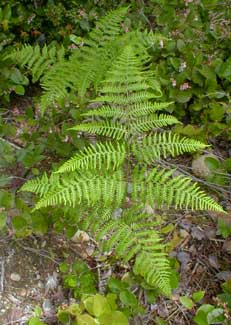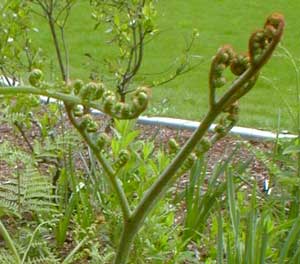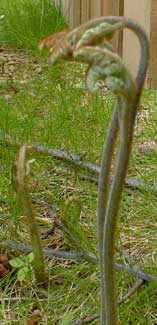
Bracken, Brake Fern,
Eagle Fern, Hogbrake,
or Female Fern
"Bramble-bush & bumble-bee,
And old red bracken smoulders still
Among boulders on the hill,
Far too bright to seem quite dead."
-Robert Graves
(1895-1985)
(1895-1985)
One of the most common ferns in the Pacific Northwest is Pteridium aquilinum, or Bracken. It's found at high & low elevations, in coastal maritime & inland nearly desert conditions. Their fuller range extends pretty much to the entire world.
Unlike the majority of ferns, bracken is drought tolerant & likes open sunny meadows, prairies, forest edges, rocky hillsides, generally in full sun or bright shade, & bracken prefers recently disrupted soil to get started.
Bracken is frequently regarded a pest-plant, especially on grazing lands where it has proven deadly to cattle. But for gardens, they are among that small fraternity of wild plants you can either embrace & admire for their positive traits, or increasingly hate them after each failure to eradicate them.
hey're highly variable ferns, from two or three feet tall & kind of delicate, to six feet tall (in some places around the world, ten feet tall) with such a sturdy central leader that as children we would pull them out of the ground, strip off the side branches, & regarding the root as a "spear point," chuck ferns at one another like javelins.
 Though they certainly can erupt from spores in recently turned earth , they more often spread vegetatively, via underground rhizomes. The oldest clones are believed to be 1,500 years old. And by the fossil evidence, the genus has been around since the Amphibian Age when mosses & ferns were the only land-based plants.
Though they certainly can erupt from spores in recently turned earth , they more often spread vegetatively, via underground rhizomes. The oldest clones are believed to be 1,500 years old. And by the fossil evidence, the genus has been around since the Amphibian Age when mosses & ferns were the only land-based plants.Bracken emerges as fiddleheads & crosiers that were eaten by the first nations of Western Washington. They fiddleheads were eaten fresh & the roots were roasted & pealed to eat as a starchy food, or pounded into flour, formed into cakes mixed with deer or bear tallow, & stored for later use.
Women of the first nations performed a rudimentary form of agriculture. Locations where camas flower roots were harvested seasonally would be periodically burned off so that the camas would never be displaced by shrubs or trees as would happen in an evolving landscape. Bracken was a secondary burn-area harvest.
They are a standard Japanese food product. On woodland treks, it is not uncommon to encounter Asian families collecting fiddleheads, which are marketed in ethnic grocery stores.
However, increased incident of stomach & oesophageal cancers in Japan, New Zealand, & Brazil has been tenuously linked to consumption of bracken fiddleheads as a regular part of diet in these countries. Raw brackens are certainly toxic to people & livestock, containing ptaquiloside as a carcinogen, besides hydrogen cyanide & sesquiterpene as immediate toxins.
Cattle that have grazed large amounts of bracken experience bladder lesions, malignant catarrhal fever, & urinary carcinomas. Bracken is the only plant proven to cause cancer in animals. Also, the incident of human cancers has been shown to increase statistically in areas where livestock has frequent access to bracken. Additional indicators show that individuals who live twenty years or longer in areas with large populations of brackens have increased cancer risks, possibly from nothing more than breathing spores.
While causality for human illness from eating bracken is not proven, plausibility is present. Toxins break down in cooking, but the traditional light frying or quick parboiling is insufficient to break down potentially harmful chemical components. Bracken should be cooked at high temperatures to be safe, & are quite easy to prepare correctly in woks.
It is not recommended to eat rare bracken under any circumstances because of the statistical increase in cancers in countries where brackens are a consumed in high numbers. Ostrich Ferns are of such low toxicity as to be far preferable to meet the dietary interest in fiddleheads. But as a well-cooked food item eaten only occasionally, there is no indication of risk from bracken. Plausible risk is restricted to the accumulative effects over time from consumptions of high amounts of bracken parboiled or so briefly cooked as to still contain toxins.
I have often eaten fiddleheads obtained from Owajimaya Japanese Grocery & even upon rare occasion as a novelty in produce departments of regular grocery stores. I have not attempted to distinguish bracken from ostrich ferns. I always "overcook" them in either case. I pan-fry bracken in hot oil until they get a touch of browning, add butter & sesame seeds as it cools, then a touch of soysauce before serving. As a side-dish or topping ingredient for rice or noodles, they are as delicious as asparagus.
I like fiddleheads so much that for a while I would purchase canned fiddleheads packaged in Japan, so as to have them out of season. They are available pickled, but I prefer them water-packed & crisp, as they are not much diminished from fresh. But I must admit the statistics on Japanese stomach cancers put me off maximizing my intake, though I do not hesitate to eat them in season well-cooked, but only at long intervals.
Bracken has many other human economic values. Up to the Victorian era it was a source of potash used in the manufacture of soap, glass, tanning agents, bleach, yellow dye, & other products. Bracken starch has been used in brewing & as a substitute for arrowroot; it is used in Japan to make confections.
Toward the end of their yearly life cycle the ferns dry out & turn brown, & have in times past been harvested when dried to use as kindling which burns hot & fast, or as a fuel to bake bricks, or shoved up a chimney & ignited to burn soot off the chimney walls. Among artisans they should even now be regarded as useful for raku pottery. Because bracken rhizomes survive forest fires & grow back more vigorous & numerous after a burn-through, their flamability is thought to be a feature of their reproductive behavior.
In Great Britain, the lost art of thatching for roofs often included thatch made of bracken. It could last up to thirty years, being far more water-resistant than straw thatch, & did not mold or ferment as does straw.

FOLKLORE OF BRACKEN
"Who's that walking on the moorland?
Who's that moving on the hill?
They are passing 'mid the bracken,
But the shadows grow and blacken
And I cannot see them clearly on the hill."
-Arthur Conan Doyle
(1859-1930)
Though not today much regarded by herbalists, historically bracken was considered medicinal. The wacky pseudo-medical system called "the doctrine of signatures" held that every plant bares a physical clue to its health benefits, a clue written there by God. Thus liverworts treat liver disease because the leaves are liver colored; lungworts treat lung disease because they are spotted like a diseased lung; red flowers treated blood diseases; yellow flowers are for jaundice; & bracken, because the fiddleheads resemble a coiled snake, treat intestinal worms. And among midwives it was believed to induce abortions for unwanted pregnancies as truly as it could expel worms.(1859-1930)
So deep was the faith in this Doctrine that practitioners failed to notice that few if any of these Signatures led to actual healing. An identical faith-based attitude, if not the Doctrine itself, predominates in today's self-vaunted alternative medicine schools of herbal lore & fantasy. Herbalists virtually never amend their received wisdom on the basis of actual studies showing their favorite herbs to have benefits equal to but no greater than placebos, although they selectively glom onto studies that leave open even the faintest glimmer of hope that their faith is correct.
Yet some herbs certainly do have distinct medicinal values even if not often the same values assigned by herbalists. Within the magical thinking of believers, a little proof for one value is interpreted as a great deal of proof for something else entirely.
Thus one does occasionally find herbalists ignoring the large body of scientific research on bracken chemistry & cancer, & recommending bracken to treat internal bleeding & stomach cramps, apparently following the cultic beliefs of modern homeopathists who recommend known toxins to treat whichever illnesses those toxins cause.
It is no great leap from bracken as a cure for ulcers to bracken as amuletic magic gathered by wiccans on Midsummer's Eve & incorporated into protective tokens used to seal on one's secrets from the mystic pryings of rival witches. This modern retiualistic use appears to be a survival of an older belief that bracken gathered on St John's Eve would confer invisibilitly upon the gatherer; or that the stipe (stem) cut near the rhizome formed the letter "X" indicative of Christ, capable of sending witches fleeing.
In old legends & literary tales, ghosts & fairies dwell always among heathers & brackens on the doomful moors. In Scottish border folklore, the Brown Man of the Muirs was a red-haired stout dwarf who wore garments made of withered brown bracken, which color lent him his title. The Brown Man was a devout vegetarian who ate berries & nuts & apples, & was threatening to whoever harmed wildlife, either tearing hunters to pieces or cursing them to ill health & painful death.